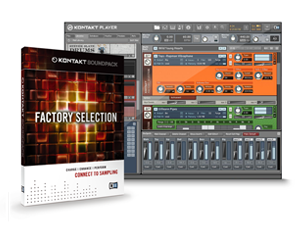
Even if you’re not a Kontakt owner, you can still make use of a nice buffet of samples and instruments drawn from the Kontakt library by using the free Kontakt player and downloading the Factory Selection:
BAND
13 instruments are taken from this collection, which contains all standard band instruments found in genres like rock, jazz, funk, pop, r’n’b and hip-hop, covering e-guitars, basses, acoustic drum-kits, a drawbar organ and various e-pianos and more.WORLD
Six world instruments are culled from the World Collection, which contains many exotic instruments from all over the globe, including flutes and reed instruments, bagpipes, plucked instruments and percussions.SYNTH
12 instruments are included from this category, putting a wide range of contemporary synth pads, basses, leads and drum kits at your disposal.VINTAGE
13 instruments are courtesy of the Vintage Collection, which handles the legendary sounds of analog synthesizers and keyboards.URBAN BEATS
Five instruments from the Urban Beats collection complete the free KONTAKT FACTORY SELECTION. Urban Beats contains ready-for-action drum loop production kits, consisting of drum loops, single loop tracks (snare, hi-hat loop etc. separated) and the individual slices.
Now here’s the bummer: the instruments can only be used in the free Kontakt 3.5 player, because the samples are in a proprietary format and not WAV or AIFF. However, you can still get some Reaktor flavored sample bending by running it through Reaktor as an effect and using something like my grain delay.





